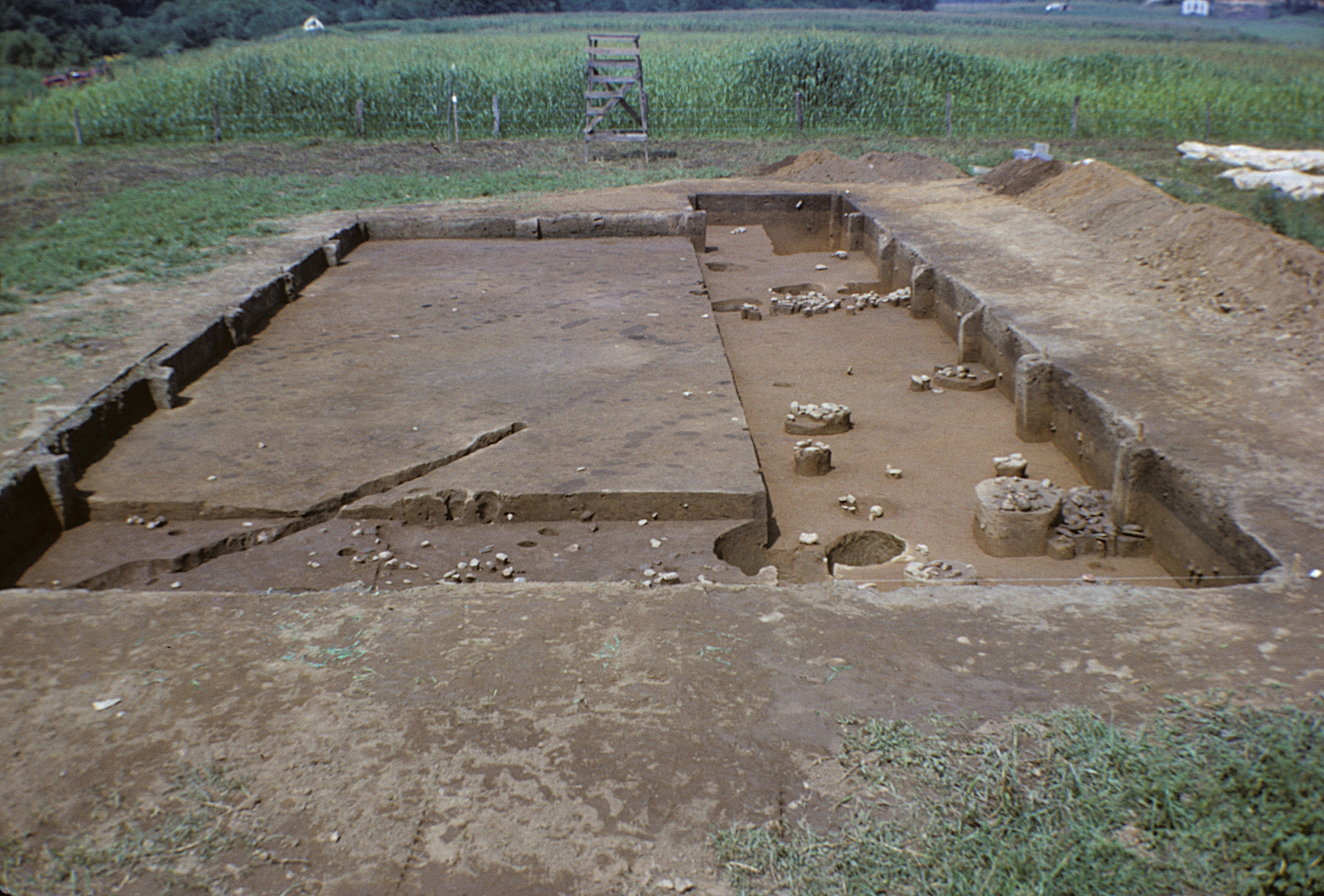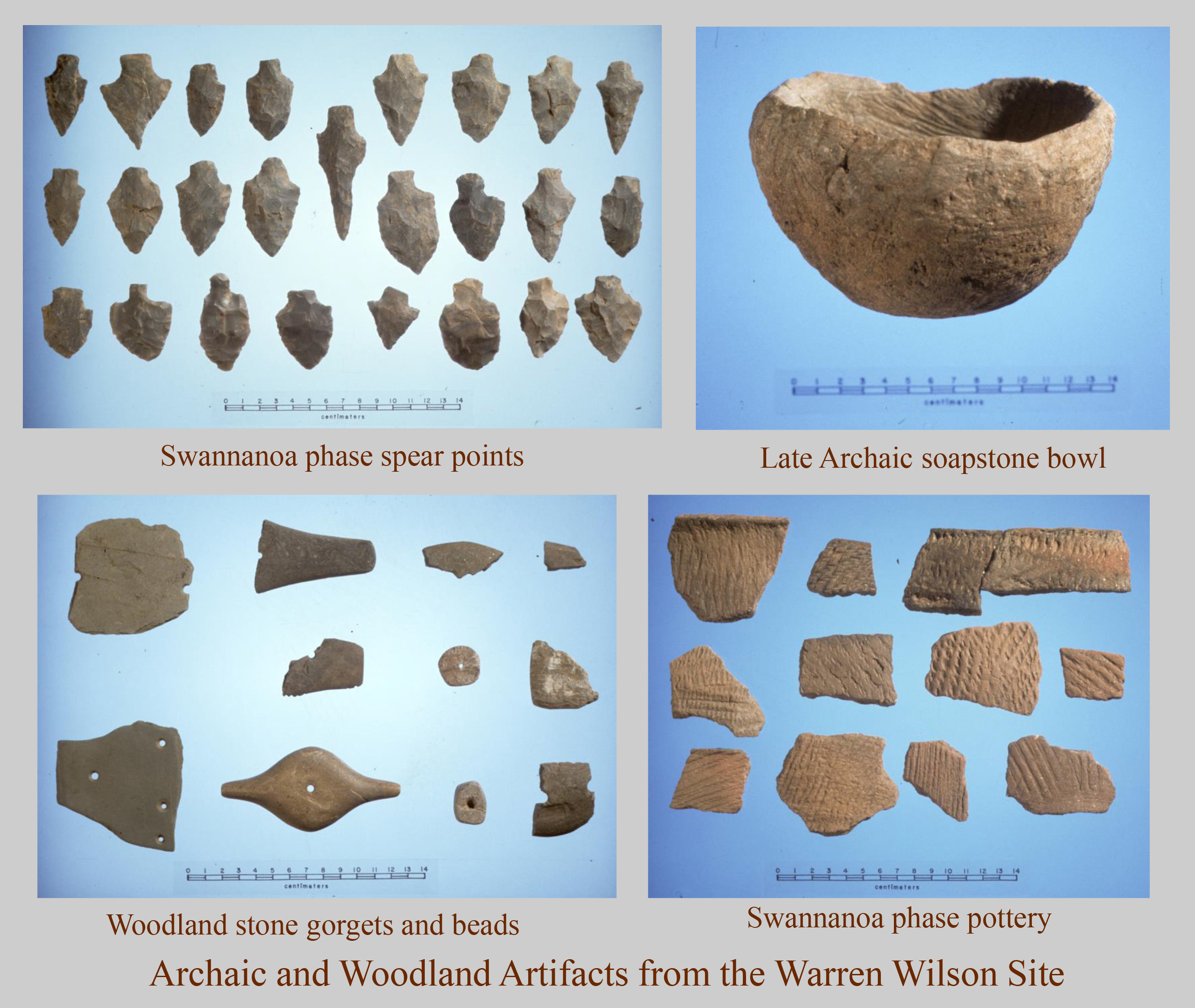Warren Wilson (Buncombe County)

Warren Wilson (31BN29) is a late prehistoric Cherokee village, located along the Swannanoa River on the Warren Wilson College campus. Importantly, the site is stratified, meaning that the layers in the soil are preserved along with the artifacts within them. The main occupation of the site happened during the Pisgah phase (A.D. 1000-1450) of the South Appalachian Mississippian tradition. Warren Wilson was excavated continuously every summer between 1966 and 1985, except for 1977 and 1983. Because of this, it has been extensively documented, and much has been written about the occupations there, including 2 books (Bennie Keel’s 1976 Cherokee Archaeology and Roy Dickens’s 1976 Cherokee Prehistory), 4 Ph.D. dissertations, 2 Master’s theses, and numerous journal articles. Data collected during the numerous archaeological excavations is still being researched by people like Dr. Christopher Rodning of Tulane University.
History of Excavations

Warren Wilson was first recorded in 1941 by Harold E. Johnston. The excavation history of Warren Wilson began during the fall of 1965, during a North American Archaeology class taught by Dr. Joffre Coe. One day a student brought in a shoe box filled with potsherds and other artifacts collected from the bottomland along the Swannanoa River on the Warren Wilson College campus. After taking a look at the artifacts, in December Coe sent Roy Dickens to the Warren Wilson campus to take a look at the site. College officials were notified and, in an attempt to make sure Dickens found material, they plowed the site as deeply as possible to bring fresh artifacts to the surface. While this did result in new artifacts, unfortunately the plowing also destroyed intact house floors and the tops of several pit features.
Excavations by the University of North Carolina began at Warren Wilson in 1966, led by Roy Dickens, and wrapped up in 1985. Later excavations were directed by Dr. David Moore, a professor at Warren Wilson College. Throughout the period of excavations, most of the student labor came from Warren Wilson College, while the field supervisors came from the University of North Carolina. Roughly half of the village has been excavated.
Research Questions

Warren Wilson is best known for its later components, but it is important to note that the site contains Archaic (8000-1000 B.C.) remains beneath the late prehistoric and historic occupations. Researchers found Savannah River Stemmed points, Otarre Stemmed points, fragments of steatite vessels, and rock-filled hearths. All of this was within a dark, organic-rich band of sandy loam beneath deposits that dated to the Early Woodland and Late Prehistoric periods. Charcoal found in two of the hearths allowed for radiocarbon dates to be taken. One of the hearths that also had a Savannah River Stemmed spear point, dated to about 3000 B.C. The other hearth did not have any diagnostic artifacts within it and dated to about 1500 B.C.
Although no food remains have been analyzed from the Late Archaic occupation at Warren Wilson, the large numbers of spear points and butchering and hide-working tools show that people at the site relied heavily on hunting. Information from southeastern Tennessee helps round out this information, showing that in addition to hunting and fishing, Late Archaic people supplemented their diets by harvesting large amounts of acorns and hickory nuts. Squash and gourds began being cultivated as early as 3000 B.C. and by the end of the Late Archaic period, sunflower, maygrass, and chenopodium were on the path towards domestication.

The Early Woodland occupation (1000-300 B.C.) at Warren Wilson is termed the Swannanoa phase. It is characterized by pottery with crushed quartz or coarse sand added to the clay as a tempering agent and extremely thick walls. Most pots have cord or fabric impressions on their exterior surfaces. Small, stemmed projectile points were also found, consisting of Swannanoa Stemmed, Plott Stemmed, and Gypsy points. These are found stratigraphically associated (within the same layer) with Transylvania Triangular points, which also seem to be associated with the introduction of the bow-and-arrow.
The most common features at Warren Wilson during the Swannanoa phase include large hearth areas with clusters of rock that were cracked apart by heat (called fire-cracked rock). Some of these hearths were over five feet across with many layers of tightly packed quartz cobbles, a pattern that is very unusual. There were also large, boat-shaped pits and several postholes, although excavators were unable to define any house structures. It is unclear if Swannanoa phase people lived at the site year round, but they clearly lived there enough to create extensive deposits.

Despite having these rich, early deposits, Warren Wilson is primarily known for its Pisgah phase excavations (A.D. 1000-1450). Pisgah settlements ranged in size from small farmsteads to relatively large nucleated villages, sometimes containing platform mounds. Small sites are usually clustered around the larger villages that have mounds and are almost always located in floodplain areas. Most sites are in the eastern and central portions of the Appalachian Summit.
Warren Wilson seems to be a typical, middle-sized Pisgah village. It covers roughly 3 acres and is surrounded by at least seven palisade lines. The inner series of palisades may have functioned as a wall, separating the central plaza from the habitation area outside. This central area may have been reserved for ceremonial and political activities, similar to square grounds seen at historic Cherokee villages. The outer band of palisades was probably a double-walled enclosure that protected the people living within the village.

Houses at Warren Wilson were roughly rectangular and measured about 20 ft. on a side. Individual posts were set in holes to make walls and most houses had a central hearth basin with prepared clay border. Entry trenches with small postholes for saplings show that half the structures had a tunnel-like entrance. All of the houses had central support posts for their interiors and some had additional posts used to form divisions within the houses. Given the cold winters in the Appalachian Summit, house walls were probably finished with cane wattle (where cane reeds were woven horizontally through the saplings) and sealed with clay, keeping in heat during the winter months. Archaeologists did not find much clay plaster, although this is probably due to the fact that none of the houses burned; without firing and hardening, plaster would rarely be preserved in the archaeological record.
At the edge of the village near the outer palisades, archaeologists found large, shallow depressions. Some of these measured over 10 ft. long and 5 ft. wide, although they were less than a foot deep. The bottoms of these depressions were often partially or completely lined with a thin layer of clay. Most had high densities of artifacts, food remains, charcoal, and fire-cracked rocks. Archaeologists interpret these features as roasting pits that could have been used to prepare large quantities of food for community-wide celebrations.
Pit hearths have also been uncovered. These were smaller than the roasting pits and may have been used to heat sweat lodges, since they were usually found inside small structures. Interestingly, however, Warren Wilson has almost no storage pits. This indicates that Pisgah people must have been using above-ground cribs and granaries, located over pits dug into the ground. The use of above-ground storage suggests that the villages may have been occupied year round; the storage buildings could not have been easily hidden and would have made easy targets for thieves and looters if they were left unattended.

In addition to the houses and food facilities, 61 burials were excavated at Warren Wilson. Most were placed inside or adjacent to a house. Bodies were placed in a fetal position with heads oriented westward and were probably wrapped with mats or furs. Burial pits were simple straight-sided pits or shaft-and-chamber pits. Grave remains consisted of ornamental items made from shell, animal bone, or mica. The most common burial objects were columella beads that were strung to create bracelets or necklaces.
In terms of Pisgah subsistence, deer and bear were the most important animals in the diet, followed by wild turkey. People also hunted squirrels, rabbits, opossum, raccoons, fish, and turtles. The floodplain environment of Warren Wilson and other Pisgah sites afforded people the opportunity to plant fields of corn, beans, squash/pumpkin, and sumpweed. In fact, half of Pisgah subsistence may have come from their agricultural produce. People also continued to collect acorns, hickory nuts, walnuts, butternuts, and a variety of fleshy fruits.

One of the most unusual discoveries at the Warren Wilson site was a feature containing an unusually large amount of toad (Bufo sp.) bones. The large, shallow pit had a single deposit of almost 14,000 toad forearm bones (radii/ulnae). The bones were found concentrated in a small area, mixed with many other animal bones. This led the faunal analyst, Dr. Jeannette Runquist, to suggest that the Pisgah people living at the site may have processed the toads for medicinal or hallucinogenic purposes. A similar discovery was made at the Qualla phase Coweeta Creek site in Macon County.
Sources:
Dickens, Roy S., Jr.
1976 • Cherokee Prehistory: The Pisgah Phase in the Appalachian Summit Region. University of Tennessee Press, Knoxville.
Ward, Trawick H., and R. P. Stephen Davis, Jr.
1999 • Time Before History: The Archaeology of North Carolina. University of North Carolina Press, Chapel Hill.
